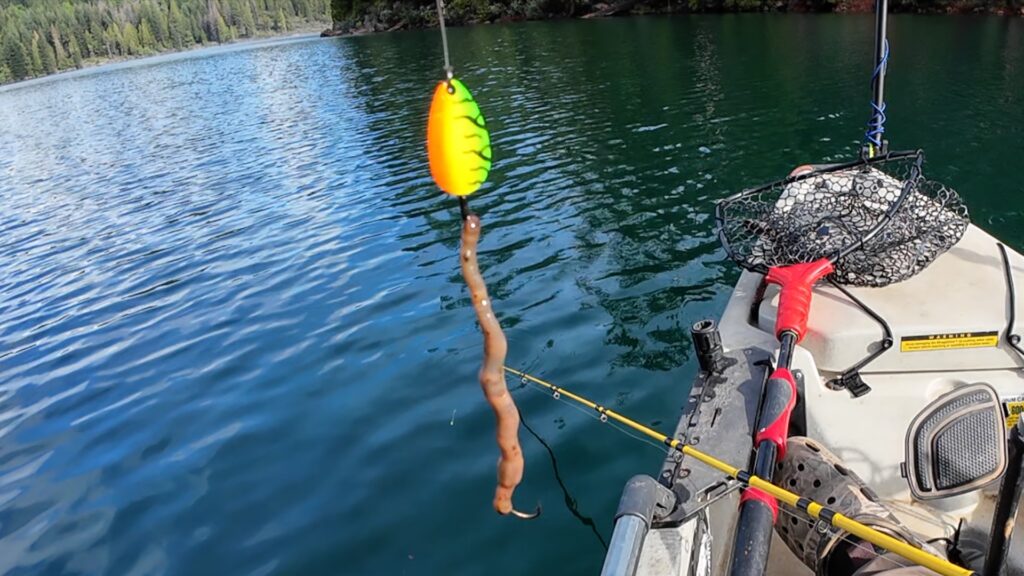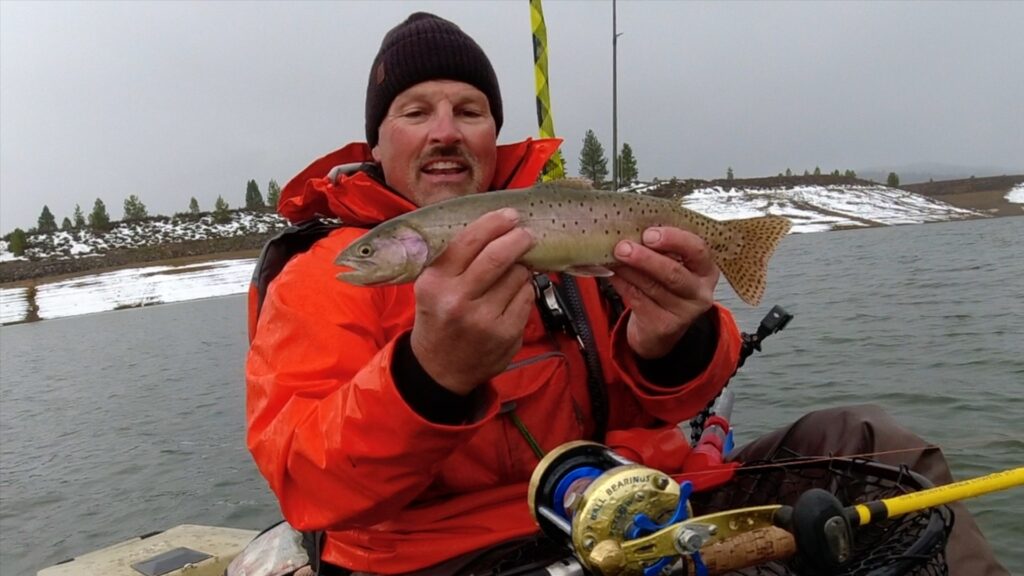Trolling With Live Bait? Naturally!
The following appears in the June issue of California Sportsman:


By Cal Kellogg
Artificial lures have been around for a very long time, but it’s a safe bet that history’s first angler employed natural bait, and that goes for history’s first trout and salmon trollers as well.
These days, with all the high-tech gear and state-of-the-art lures that are available to us, many trollers tend to overlook natural baits, despite the fact that they work as well today as they ever have.
At times, when the going gets tough or when big fish are the objective, some of the best trollers I
know reach for natural baits in the form of frozen shad, anchovies or herring, plus live baits such as nightcrawlers and minnows.
Guide Monte Smith of Gold Country Sport Fishing (goldcountryfishingguide .wpcomstaging.com) is a good example of what I’m talking about. Monte is a highly talented skipper who spends his time plying California Mother Lode lakes such as New Melones Reservoir, Lake Don Pedro and Lake McClure.

ON A ‘ROLL’
For big rainbows and browns as well as husky landlocked kings, Smith’s number one offering is frozen shad. Trolling shad – or “rolling shad,” as the technique is known among trout and salmon aficionados – closely mimics the way coastal saltwater anglers employ anchovies and herring to tempt Chinook and coho salmon into biting.
The term rolling stems from the fact that a properly rigged shad will slowly roll through the water when trolled. Predatory fish, like trout, are often in the presence of hundreds or even thousands of baitfish. Most of the time these baitfish are ignored because they are healthy and hard for the trout to chase down. Yet, a slow-moving baitfish that shows signs of distress is gobbled up in short order.
When a shad is rolled through the water, it puts off vibrations consistent with those created by an injured baitfish. From a visual standpoint, a rolling shad gives the impression of a disoriented shad minnow that has lost its ability to remain upright. Combine this with the vibrations a rolled shad creates, plus the fact that shad are the predominant forage in the majority of reservoirs, and it presents the trout with a series of cues that add up to trigger their feeding instinct.

SOAKING UP FIRM BAITS
“I soak the fresh shad I buy for trolling in brine overnight. Once I’ve brined them, I divide them among several Ziploc bags and freeze them,” Smith says. “I add blue dye to some of the shad I brine. This way, I can do some experimenting with color throughout the day as I troll.”
Soaking baitfish such as shad, anchovies and herring in brine firms and toughens them. Some anglers brine their bait by soaking it in a solution of two-thirds water, one-third ice and 1 or 2 cups of rock salt. I employ the same basic approach to brining, but I use different ingredients. Since I don’t want my shad smelling like chlorine or fluoride, I don’t use tap water.
Instead, I buy a gallon of purified water and chill it in the refrigerator. I place about a pound of baitfish in a small cooler and pour in the cold water until they are completely covered. Next, I gently mix in about a cup of Pro-Cure Brine ’N Bite. Brine ’N Bite firms and toughens the bait like rock salt does, but it also adds amino acids to the bait that excite game fish and encourages them to bite. I also add half a teaspoon of Pro-Cure Bait Brite to the brining solution.
Bait Brite is a bluing solution that adds an intense shine to your bait. After the bait and solution have been thoroughly mixed, I add several cups of small ice cubes and put the cooler in the refrigerator overnight.
The next day the baitfish will be firm and ready for fishing, or they can be separated into lots of two dozen and frozen. Freezing them in Ziploc bags works well, but you’ve got to thaw the bait out slowly in a weak brine solution with plenty of ice before using them. If you try to pry the baitfish apart while they are still frozen, you’ll damage them.
Luckily for me I’m on good terms with the butcher at one of the markets near my house. He supplies me with Styrofoam meat trays. When it’s time to freeze the baits, I take them out of the brine, dry them off and lay them out in two neat rows in one of the trays. Next, I wrap the trays with plastic wrap and pop them into the freezer. Now, I know this sounds like a lot of work, but believe me: When you hit the water with a supply of perfectly intact baitfish, you’ll be glad you spent a little extra time in preparation. Remember, it’s small details that separate great anglers from the mediocre ones.
BEING COLOR COORDINATED
As Smith attests, there are times when adding color to baitfish can really enhance their effectiveness. The guide dyes his baits blue by adding a substantial amount of the same bait brightener that I use. If you’d like to experiment with some other colors beyond blue, Pro-Cure offers a full line of Bad Azz Bait Dyes. The chartreuse is particularly effective.
Properly preparing shad is only part of the equation. The real challenge comes in rigging them so they display the proper rolling motion when drawn through the water.
“Bait holders are simple to use and there is no doubt that they will catch fish. Overall, I think the plastic head is too prominent. The whole point of using shad is to present the trout and salmon with a natural bait. I think this goal is defeated when you add a plastic holder to the head of the bait,” Smith relates.

PLAYING HOOKY
Smith ties a simple two-hook monofilament leader that imparts rotation to the shad while allowing the bait to maintain a natural appearance. The leader consists of a 36-inch section of 8-pound-test fluorocarbon line tipped with a
No. 8 or 10 red-colored treble hook. Above the treble he slides on a small bead, then attaches a No. 8 or 10 red-colored octopus hook on a sliding snell. To tie a sliding snell, the first thing you must do is acquire a knot-tying guide or go on the internet and find an illustration of how to snell a hook.
The sliding snell uses the same knot, the only difference being the piece of line the octopus hook is snelled on is separate from the leader. As the snell knot is tied, the line is wrapped around the leader. When the knot is finished and trimmed you are left with the octopus hook attached to the leader in such a way that it can be slid up or down. If this sounds complicated, it is at first, but with a little practice it becomes pretty easy. I’ve seen some anglers simplify the process by using a pair of small rubber bobber stops to hold the octopus hook in place on the leader. The octopus hook’s ability to slide on the leader is very important since this is what ultimately makes the shad rotate.
This is how it works. Select a shad and imbed one of the treble’s points in its vent near the base of the tail. Next, pin the octopus hook upward through the shad’s nose. With the two hooks in the bait, slide the octopus down toward the shad’s tail until a curve is created in its body. It is this curve that causes the bait to rotate. One of the nice things about using this type of leader is that it allows the angler to experiment with the intensity of the bait’s spin. The straighter the curve in the bait, the less it will roll; the sharper the curve, the more violent the spin.
“I usually troll between .75 and 1 mile per hour when using shad. As a general rule, when I’m targeting trout exclusively, I’ll start out with my bait rigged fairly straight and troll at the upper end of this speed range,” Smith says. “Kings tend to mouth shad without pulling the line out of the downrigger release. If kings are around, it is important to keep an eye on the rod. If you see any tugs, pop the line out of the release and start reeling. Trout usually hammer shad and have no problem pulling the line out of the clip.”

CRAVING ’CRAWLERS
Over the years, when exploring new lakes or targeting trout that are playing hard to get, I have not found anything as effective as a threaded nightcrawler.
To rig a threaded worm, I start off by snelling a No. 2 Mustad Slow Death hook on the end of a 36-inch, 8-pound-test fluorocarbon leader. Next, I take out a nightcrawler and slide it onto my worm threader. If you’ve never seen a worm threader, it is a simple wooden handle with an 8-inch section of fine-diameter metal tube embedded in it. The tip of the tube is cut off at a sharp angle. Once I have the ’crawler impaled on the threader, I slide it down to the handle.
After that I place the hook tip in the end of the tube and pull it down tight by gripping the leader against the wooden handle. The final step is to slide the ’crawler up the threader, over the bend of the hook and down the leader.
A nightcrawler threaded like this can be fished a number of different ways. You can tie the leader to a swivel knotted to the end of your main line and pull it from .50 to 1 mile per hour. Rigged like this the worm will spin and glide through the water, making an inviting target for trout.
My all-time favorite approach is to pull a threaded ’crawler 12 to 18 inches behind a small dodger in a watermelon pattern. The only time I go with a larger dodger is when the water is discolored or if I’m working in really deep water. A threaded nightcrawler pulled 18 inches behind a set of silver or brass flashers is an old-school favorite that has been catching big numbers of trout for decades.
THE SMART PLAY
When trout are spooky or finicky, it is important to play out your bites, especially when using a plain threaded nightcrawler or one teamed with just a small dodger. A trout that grabs a worm is not expecting to feel resistance. By playing out a bite, I’m referring to feeding the trout some slack when it hits. If the trout are being tentative, a worm strike usually begins with a few taps. When I see that, I immediately pop the line out of the downrigger clip and drop the reel into free spool, giving the trout a five- or 10-count before beginning to retrieve the line. This allows trout to eat the bait while feeling minimal resistance.
Are natural baits always the answer for trout trolling? While they will hook fish in most situations, they are not always the best choice. You are better off using artificial lures whenever possible, since they are easy to use and offer a high degree of versatility.
However, when the odds stack up against you and most anglers are struggling to hook trout, don’t hesitate to try pulling real meat. Naturals have kept me from getting skunked more times than I can count, and they’ll do the same for you. CS
Editor’s note: Cal Kellogg is a longtime Northern California outdoors writer. Subscribe to his YouTube channel Fish Hunt Shoot Productions at youtube.com/ user/KelloggOutdoors.



